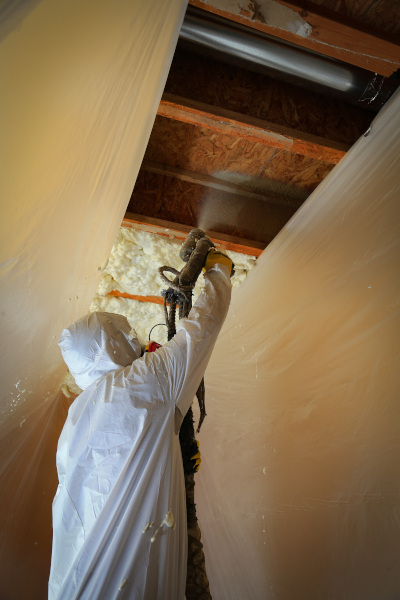
When evaluating their comfort levels throughout their home, homeowners will often point to the room above the garage as one of the areas that is most often too cold in the winter or too hot in the summertime. Having an attached garage is a great convenience during bad weather, but often this comes with the drawback of having the cold/hot garage right against your living space. Most homeowners do not want to install heating and cooling in the garage, so in order to prevent heat transfer to the living space, the walls and the ceiling of the garage are insulated. Typically builders will install the cheapest insulation material( fiberglass batts), and then count on the drywall to act as an air barrier between the garage and the house. This works well on the walls between the garage and the house, but this solution fails when it comes to the ceiling between the garage and living space above. This is because the space between the drywall in the garage ceiling and floor above is often 10-12 inches deep. Typically, builders will insulate with a fiberglass batt that is between 3-9 inches in thickness. Over time the fiberglass in the ceiling will start to sag and eventually fall down within the cavity, until it is no longer making contact with the floor above.
When the material is simply sitting on top of drywall in the garage ceiling, it no longer prevents heat transfer between the two areas. The problem is further exacerbated by the fact that cold air often finds a way to infiltrate around the perimeter of the garage ceiling. What you are left with is a very cold/warm garage, which is very well connected to your living space, and unfortunately the drywall ceiling prevents you from having a quick solution to the problem.

The room above the garage is too hot in the summer/too cold in the winter.
Bathroom water pipes above the garage have a problem with freezing.
The master bathroom above the garage has uncomfortably cold floors in the wintertime.
The loft area above the garage is a much different temperature than the rest of the home.


The old method of insulating a garage ceiling was to drill holes into every bay of the garage ceiling, fill the cavities with cellulose insulation, and then patch the holes with wooden plugs. Due to the lack of visuals into the cavity, installers would take a guess as to when to stop filling the bays with insulation. This method could lead to underfilling the cavity which would not fix the comfort issue, or overpacking the cavity and causing the drywall ceiling to start sagging over time. Cellulose is a messy and dense material, which means that working with it requires a lot more precision and more clean up when the job is done.
In order to prevent these issues, Atlas technicians use spray foam insulation instead of cellulose. We start the process of insulating your garage ceiling by making strategic cuts in the drywall that minimize how much drywall needs to be removed while leaving all areas completely accessible for treatment. The existing insulation will be removed and be properly disposed of. With the old insulation out of the way, our technicians will completely fill the garage ceiling cavities with spray foam insulation. Full-filing these cavities maximizes the insulation value, and because the spray foam directly adheres to the floor above, you never have to worry about sagging insulation in the future. The spray foam insulation will also act as a proper air barrier which will stop air movement into the cavity tackling two problems at the same time. After we are done insulating we patch the drywall ceiling back to the existing finish, so your garage ceiling looks exactly as it did before the work!
By choosing Atlas Home Energy for your home upgrades, we promise to:
Effective Date: 09/05/2023
This Privacy Policy explains how Atlas Home Energy Solutions collects, uses, and discloses personal information about our customers, prospective customers, and visitors to our website at www.atlashomeenergy.com.
Information collected directly from you: We may collect personal information directly from you, for example through a web form, while scheduling a service, when you contact us for customer support, or upon signing a contract for service. Personal information we collect directly from you may include first and last name, address, email address, and phone number.
Information collected from your device: Our website may use technologies such as cookies, web beacons, pixels, and other similar technologies to automatically collect certain information from your device including, for example, your IP address, date and time of your visit, browser and operating system information, referring website address, and other information about how you interact with the website. Our website may also use cookies and similar technologies to enhance your user experience and enable certain features. Our email campaigns may also use tracking technologies such as web beacons, pixels, and other similar technologies to automatically collect certain information such as IP address, browser type and version, and email engagement statistics.
Information collected from your partners: We may collect personal information about you from our third-party partners and combine it with other information that we collect. Personal information we collect from our partners may include, for example, your demographic information, shopping history, and geographic location.
Personal information collected from you may be used to contact you via SMS Text, Email, or Phone in order to: schedule you for an estimate or consultation, respond to customer service inquiries, complete home improvement services, confirm upcoming service appointments and to request feedback for services performed. At no time will your personal information be distributed or sold to third parties for marketing purposes.